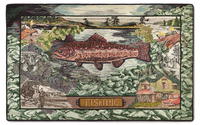North American Orientals
A passion for Middle Eastern rugs in traditional rug hooking part one of a series

An Edward Sands Frost pattern called Frost Oriental, available from W. Cushing & Co.
The history of North American rug hookers replicating Oriental rugs is long and unbroken. Makeshift and commercial patterns emerged as early as the 1870s from Edward Sands Frost’s collection. The reason, no doubt, was that original handwoven rugs from the Middle East were far too expensive to own, but their beauty too enticing to withstand. Although early hooked Oriental rugs were done in larger cuts than we see now, the advent of finer cuts allowed the detailing of Orientals to become more sophisticated. As hooked Orientals became popular, it was possible to introduce color plans based on decorating schemes that varied widely from traditional Far Eastern rugs. Deep reds, blues, and golds were replaced by soft pastels that suited the rug hooker’s home decor. Working from a pattern allowed the rug hooker to color plan the entire piece much the same way as any other pattern, except that the backgrounds, or fields, had to be considered first. Smaller motifs (and they were never as small as actual Middle Eastern rug motifs) could be chosen second, since the larger fields, not the motifs, determined the overall color scheme.
North American Orientals were never going to be mistaken for Middle Eastern ones. This category of hooked Orientals has become its own phenomenon, and one deserving special attention.
Histories of Oriental rugs abound and are not really what we’re concerned with here. Although admiration of true Middle Eastern Oriental rugs continues, the breakaway into something decidedly North American has already happened—all that remains is a careful examination of the phenomenon and more information on how to actually hook them.
Hooking Orientals was always seen as challenging, even somewhat mysterious, requiring access to specialized teachers. It may help to break down the process over the next several articles and examine patterns, technique, color, and design elements in the hopes of demystifying the subject. We can all bring our own sense of design and what “works” into the discussion as well—after all, any rug is still an arrangement of colors and motifs, and we’re all versed in that.
We’re calling this series of articles “North American Orientals: A Passion for Middle Eastern Rugs in Traditional Rug Hooking.”








